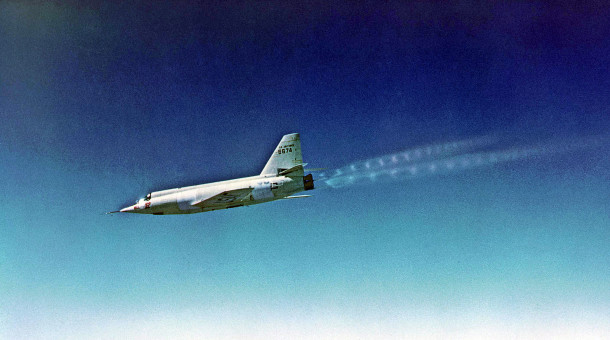
Sixty-four years ago today, the No. 1 USAF/Bell X-2 rocket-powered flight research aircraft reached a record speed of 2,094 mph with USAF Captain Milburn G. “Mel” Apt at the controls. However, triumph quickly turned to tragedy when the aircraft departed controlled flight, crashed to destruction, and Apt perished.
Mel Apt’s historic achievement came about because of the Air Force’s desire to have the X-2 reach Mach 3 before turning it over to the National Advisory Committee For Aeronautics (NACA) for further flight research testing. Just 20 days prior to Apt’s flight in the X-2, USAF Captain Iven C. Kincheloe, Jr. had flown the aircraft to a record altitude of 126,200 feet.
On Thursday, 27 September 1956, Apt and the X-2 (Ship No. 1, S/N 46-674) dropped away from the USAF B-50 mothership at 30,000 feet and 225 mph. Despite the fact that Mel Apt had never flown an X-aircraft, he executed the flight profile exactly as briefed. In addition, the X-2′s twin-chamber XLR-25 rocket motor burned propellant 12.5 seconds longer than planned. Both of these factors contributed to the aircraft attaining a speed in excess of 2,000 mph.
Apt and his aerial steed hit a peak Mach number of 3.2 at an altitude of 65,000 feet. Based on previous flight tests as well as flight simulator sessions, Apt knew that the X-2 had to slow to roughly Mach 2.4 before turning the aircraft back to Edwards. This was due to degraded directional stability, control reversal, and aerodynamic coupling issues that adversely affected the X-2 at higher Mach numbers.
However, Mel Apt was now faced with a difficult decision. If he waited for the X-2 to slow to Mach 2.4 before initiating a turn back to Edwards Air Force Base, he quite likely would not have enough energy and therefore range to reach Rogers Dry Lake. On the other hand, if he decided to initiate the turn back to Edwards at high Mach number, he risked having the X-2 depart controlled flight. Flying in a coffin corner of the X-2’s flight envelope, Apt opted for the latter.
As Apt increased the aircraft’s angle-of-attack, the X-2 departed controlled flight and subjected him to a brutal pounding. Aircraft lateral acceleration varied between +6 and -6 g’s. The battered pilot ultimately found himself in a subsonic, inverted spin at 40,000 feet. At this point, Apt effected pyrotechnic separation of the X-2′s forebody which contained the cockpit and a drogue parachute.
X-2 forebody separation was clean and the drogue parachute deployed properly. However, Apt still needed to bail out of the descending unit and deploy his personal parachute to complete the emergency egress process. However, such was not to be. Mel Apt ran out of time, altitude, and luck. The young pilot lost his life when the X-2 forebody from which he was trying to escape impacted the ground at a speed of one hundred and twenty miles an hour.
Mel Apt’s flight to Mach 3.2 established a record that stood until the X-15 exceeded that mark in August 1960. However, the price for doing so was very high. The USAF lost a brave test pilot and the lone remaining X-2 on that fateful day in September 1956. The mishap also ended the USAF X-2 Program. NACA never did conduct flight research with the X-2.
However, for a few terrifying moments, Mel Apt was the fastest man alive.

Sixty-four years ago today, the rocket-powered USAF/Bell X-2 aircraft established a new altitude record when the vehicle soared to 126,200 feet above sea level. This historic accomplishment took place on the penultimate mission of the type’s troubled 20-flight aeronautical research program.
The X-2 was the successor to Bell’s X-1A rocket-powered aircraft which had recorded maximum speed and altitude marks of 1,650 mph (Mach 2.44) and 90,440 feet, respectively. The X-2 was designed to fly beyond Mach 3 and above 100,000 feet. The X-2’s primary mission was to investigate aircraft flight control and aerodynamic heating in the triple-sonic flight regime.
The X-2 had a gross take-off weight of 24,910 lbs and was powered by a Curtis-Wright XLR-25 rocket motor which generated 15,000-lbs of thrust. Aircraft empty weight was 12,375 lbs. Like the majority of X-aircraft, the X-2 was air-launched from a mothership. In the X-2’s case, an USAF EB-50D served as the drop aircraft. The X-2 was released from the launch aircraft at 225 mph and 30,000 feet.
The day was Friday, 07 September 1956. The pilot for the X-2 maximum altitude mission was USAF Captain Iven Carl Kincheloe, Jr. Kincheloe was a Korean War veteran and highly accomplished test pilot. He wore a partial pressure suit for survival at extreme altitude.
While the dynamic pressure at the apex of his trajectory was only 19 psf, Kincheloe successfully piloted the X-2 with aerodynamic controls only. The X-2 was not configured with reaction controls. Mach number over the top of the trajectory was supersonic (approximately Mach 1.7).
Kincheloe’s maximum altitude flight in the X-2 (S/N 46-674) would remain the highest altitude achieved by a manned aircraft until August of 1960 when the fabled X-15 would fly just beyond 136,000 feet. However, for his achievement on that late summer day in 1956, the popular press would refer to Iven Kincheloe as the “First of the Space Men”.
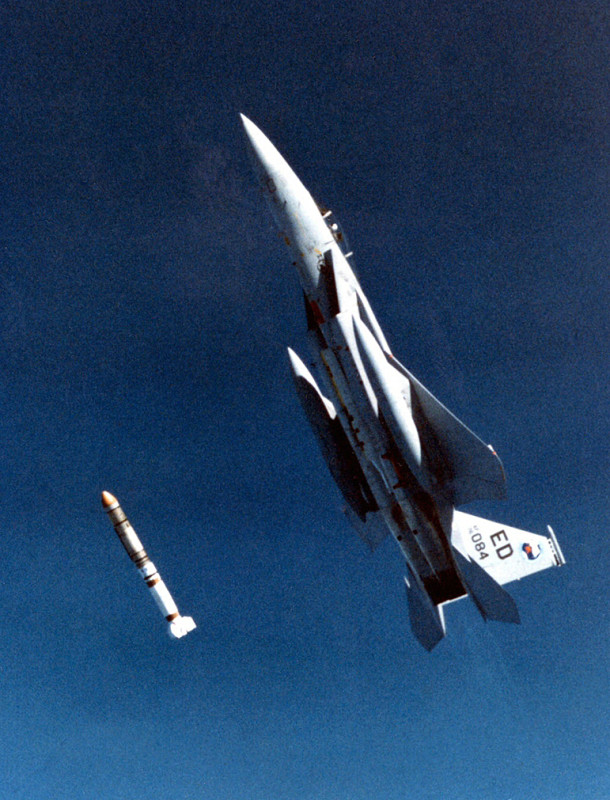
Thirty-five years ago this month, the USAF/LTV ASM-135 anti-satellite missile successfully intercepted a target satellite orbiting 300 nautical miles above surface of the Earth. The historic test was the first and only time that an aircraft-launched missile successfully engaged and destroyed an orbiting spacecraft.
The United States began testing anti-satellite missiles in the late 1950′s. These and subsequent vehicles used nuclear warheads to destroy orbiting satellites. A serious disadvantage of this approach was that a nuclear detonation intended to destroy an adversary satellite will likely damage nearby friendly satellites as well.
By the mid 1970′s, the favored anti-satellite (ASAT) approach had changed from nuclear detonation to kinetic kill. This latter approach required the interceptor to directly hit the target. The 15,000-mph closing velocity provided enough kinetic energy to totally destroy the target. Thus, no warhead was required.
The decision to proceed with development and deployment of an American kinetic kill weapon was made by President Jimmy Carter in 1978. Carter’s decision came in the aftermath of the Soviet Union’s successful demonstration of an orbital anti-satellite system.
LTV Aerospace was awarded a contract in 1979 to develop the Air-Launched Miniature Vehicle (ALMV) for the USAF. The resulting anti-satellite missile (ASM) system was designated the ASM-135. The two-stage missile was to be air-launched by a USAF F-15A Eagle executing a zoom climb. In essence, the aircraft acted as the first stage of what was effectively a 3-stage vehicle.
The ASM-135 was 18-feet in length and 20-inches diameter. The 2,600-lb vehicle was launched from the centerline station of the host aircraft. The ASM consisted of a Boeing SRAM first stage and an LTV Altair 3 second stage. The vehicle’s payload was a 30-lb kinetic kill weapon known as the Miniature Homing Vehicle (MHV).
The ASM-135 was first tested in flight on Saturday, 21 January 1984. While successful, the missile did not carry a MHV. On Tuesday, 13 November 1984, a second ASM-135 test took place. Unfortunately, the missile failed when the MHV that it was carrying was aimed at a star that served as a virtual target. Engineers went to work to make the needed fixes.
In August of 1985, a decision was made by President Ronald Reagan to launch the next ASM-135 missile against an orbiting US satellite. The Solwind P78-1 satellite would serve as the target. Congress was subsequently notified by the Executive Branch regarding the intended mission.
The historic satellite takedown mission occurred on Friday, 13 September 1985. USAF F-15A (S/N 77-0084), stationed at Edwards Air Force Base, California and code-named Celestial Eagle, departed nearby Vandenberg Air Force Base carrying the ASM-135 test package. Major Wilbert D. Pearson was at the controls of the Celestial Eagle.
Flying over the Pacific Ocean at Mach 1.22, Pearson executed a 3.8-g pull to achieve a 65-degree inertial pitch angle in a zoom climb. As the aircraft passed through 38,000-feet at Mach 0.93, the ASM-135 was launched at a position 200 miles west of Vandenberg. Both stages fired properly and the MHV intercepted the Solwind P78-1 satellite within 6-inches of the aim point. The 2,000-lb satellite was completely obliterated.
In the aftermath of the stunningly successful takedown of the Solwind P78-1 satellite, USAF was primed to continue testing the ASM-135 and then introduce it into the inventory. Plans called for upwards of 112 ASM-135 rounds to be flown on F-15A aircraft stationed at McChord AFB in Washington state and Langley AFB in Virginia. However, such was not to be.
Even before the vehicle flew, the United States Congress acted to increasingly restrict the ASM-135 effort. A ban on using the ASM-135 against a space target was put into effect in December 1985. Although USAF actually conducted successful additional ASM-135 flight tests against celestial virtual targets in 1986, the death knell for the program had been sounded.
In the final analysis, a combination of US-Soviet treaty concerns, tepid USAF support, and escalating costs killed the ASM-135 anti-satellite effort. The Reagan Administration formally cancelled the program in 1988.
While the ASM-135 effort was relatively short-lived, the technology that it spawned has propagated to similar applications. Indeed, today’s premier exoatmospheric hit-to-kill interceptor, the United States Navy SM-3 Block IA anti-ballistic missile, is a beneficiary of ASM-135 homing guidance, intercept trajectory and kinetic kill weapon technologies.
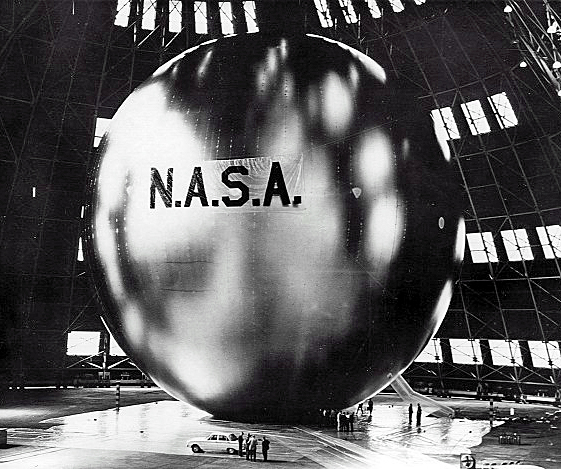
Sixty years ago this month, the United States successfully launched the Echo 1A passive communications satellite into Earth orbit. The 100-foot diameter balloon was among the largest objects ever to orbit the Earth.
A plethora of earth-orbiting communication satellites provide for a global connectivity that is commonplace today. Such was not always the case. Roll the clock back more than a half-century and we find that a global communications satellite system was just a concept. However, keen minds would soon go to work and provide mankind with yet another tangible space age benefit.
Communications satellites are basically of two types; passive and active. A passive communications satellite (PCS) simply reflects signals sent to it from a point on Earth to other points on the globe. An active communications satellite (ACS) can receive, store, modify and/or transmit Earth-based signals.
The earliest idea for a PCS involved the use of an orbiting spherical balloon. The balloon was fabricated from Mylar polyester having a thickness of a mere 0.5 mil. The uninflated balloon was packed tightly into a small volume and inserted into a payload canister preparatory to launch. Once in orbit, the balloon was released and then inflated to a diameter of 100 feet.
The system described above materialized in the late 1950′s as Project Echo. The Project Echo satellite was essentially a huge spherical reflector for transcontinental and intercontinental telephone, radio and television signals. The satellite was configured with several transmitters for tracking and telemetry purposes. Power was provided by an array of nickel-cadmium batteries that were charged via solar cells.
Echo 1 was launched from Cape Canaveral, Florida on Friday, 13 May 1960. However, the launch vehicle failed and Echo 1 never achieved orbit. Echo 1A (sometimes referred to as Echo 1) lifted-off from Cape Canaveral’s LC-17A at 0939 UTC on Friday, 12 August 1960. The Thor Delta launch vehicle successfully placed the 166-lb satellite into a 820-nm x 911-nm orbit.
An interesting characteristic of the Echo satellite was the large oscillation in the perigee of its orbit (485 nm to 811 nm) over several months. This was caused by the influences of solar radiation and variations in atmospheric density. While these factors are just part of the earth-orbital environment, their effects were much more noticeable for Echo due to the type’s large surface area-to-weight ratio.
Echo 1A orbited the Earth until it reentered the Earth’s atmosphere on Saturday, 25 May 1968. Echo 2 was a larger and improved version of Echo 1A. It measured 135-feet in diameter and weighed 547-lb. Echo 2 orbited the Earth between January of 1964 and June of 1969. Other than the Moon, both satellites were the brightest objects observable in the night sky due to their high reflectivity.
The Echo satellites served their function admirably. For a time, they were quite a novelty. However, progress on the ACS scene quickly relegated the PCS to obsolescence. Today, virtually all communication satellites are of the ACS variety.
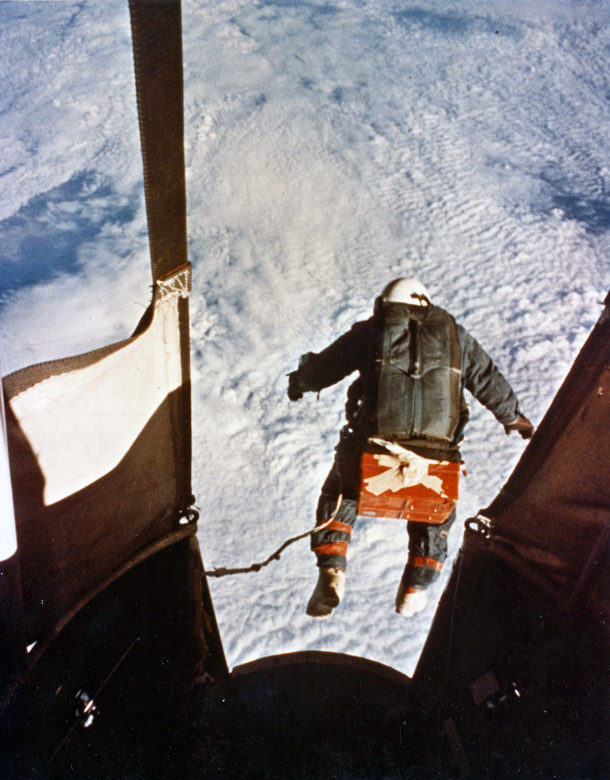
Sixty years ago this week, USAF Captain Joseph W. Kittinger, Jr. successfully completed a daring parachute jump from 102,800 feet (19.5 miles). The historic bailout took place over the Tularosa Basin of New Mexico.
Kittinger’s jump was the final mission of the three-jump Project Excelsior flight research effort which focused on manned testing of the Beaupre Multi-Stage Parachute Parachute (BMSP). The system was being developed to provide USAF pilots with a means of survival from an extreme altitude ejection.
Transport to jump altitude was via a 3-million cubic foot helium balloon. Kittinger rode in an open gondola. He was protected from the harsh environment by an MC-3 partial pressure suit as well as an assortment of heavy cold-weather clothing. Kittinger and his jump wardrobe and flight gear weighed a total of 313 pounds
The Excelsior III mission was launched just north of Alamogordo, New Mexico at 11:29 UTC on Tuesday, 16 August 1960. Ninety-three minutes later, Kittinger’s fragile balloon reached float altitude. At 13:12 UTC, Kittinger stepped out of the gondola and into space. As he did so, he said: “Lord, take care of me now!”
The historic record shows that Joe Kittinger experienced a free-fall that lasted 4 minutes and 36 seconds. During this time, he fell 85,300 feet (16.2 miles). Incredibly, Kittinger reached a maximum free-fall velocity of 614 miles per hour (Mach 0.92) passing through 90,000 feet.
The BMSP worked as advertised. Kittinger entered the cloud deck obscuring his Tularosa Basin landing point at 21,000 feet. Main parachute deployment occurred at 17,500 feet. Total elapsed time from bailout to touchdown was 13 minutes and 45 seconds.
While Joe Kittinger and the Excelsior team focused on flight testing technology critical to the survival of fellow aviators, a byproduct of their efforts were aviation records that stood for over 50 years. Those achievements include: highest parachute jump (102,800 feet), longest free-fall duration (4 minutes 36 seconds – this record still stands), and longest free-fall distance (85,300 feet).

Fifty-six years ago this month, the fabled North American X-15 hit a speed of 3,590 mph (Mach 5.23) in a flight that reached an altitude of 103,300 feet. While decelerating through Mach 4.2, the nose gear of the aircraft unexpectedly deployed in flight.
The 114th powered flight of the legendary X-15 Program took place on Friday, 14 August 1964. USAF Major Robert A. Rushworth was at the controls of X-15 Ship No. 2 (S/N 56-6671). The mission would be Rushworth’s 22nd flight in the famed hypersonic aircraft.
X-15 drop from the NB-52A (S/N 52-0003) launch aircraft took place over Delamar Dry Lake, Nevada. Seconds later, Rushworth called for 100% power from the X-15’s XLR-99 liquid-fueled rocket engine as he pulled into a steep climb. He subsequently pushed-over and then leveled-off at 103,300 feet.
XLR-99 burnout occurred 80.3 seconds after ignition. At this juncture, the X-15 was traveling at 3,590 mph; better than 5 times the speed of sound. Following rocket motor burnout, the aircraft slowed and began to lose altitude under the influence of weight and aerodynamic drag.
As the Mach meter needle passed through Mach 4.2, Rushworth heard a loud bang from the airframe. The aircraft became hard to control as it gyrated in pitch, yaw and roll. Rushworth was equal to the moment and brought his troubled steed under control. However, the aircraft had an uncommanded sideslip and Rushworth had to use left aileron to hold the wings level.
Gathering his wits, Rushworth realized that the loud bang he heard was very similar to that which occurred when the nose gear was deployed in the landing pattern. Unaccountably, the X-15 nose gear had deployed in supersonic flight. An unsettling confirmation of Rushworth’s hypothesis came when the pilot spotted smoke, quite a bit of it, in the X-15 cockpit.
As Rushworth neared Edwards Air Force Base, chase aircraft caught up with him and confirmed that the nose gear was indeed down and locked. Further, the tires were so scorched from aerodynamic heating that they probably would disintegrate during touchdown on Rogers Dry Lake. They verily did.
Despite his tireless nose gear, Rushworth was able to control the rollout of his aircraft fairly well on the playa silt. He brought the X-15 to a stop and deplaned. Man and machine had survived to fly another day.
Post-flight analysis revealed that expansion of the X-15 fuselage due to aerodynamic heating was greater than expected. The nose gear door bowed or deformed outward more than anticipated as well. Together, these two anomalies caused the gear uplock hook to bend and release the nose gear. Fixes were subsequently made to Ship No. 2 to prevent a recurrence of the nose gear door deployment anomaly.
Rushworth next flew X-15 Ship No. 2 on Tuesday, 29 September 1964. He reached a maximum speed of 3,542 mph (Mach 5.2) at 97,800 feet. The nose gear door remained locked. However, while decelerating through Mach 4.5, Rushworth heard a bang that was less intense than the previous flight. This time, thermal stresses caused the nose gear door air scoop to deploy in flight. While the aircraft handled poorly, Rushworth managed to get it and himself back on the ground in one piece.
Following another redesign effort, Rushworth took to the air in X-15 Ship No. 2 on Thursday, 17 February 1965. He hit 3,539 mph (Mach 5.27) at 95,100 feet. On this occasion, both the nose gear door and nose gear door scoop remained in place. Unfortunately, the right main landing skid deployed at Mach 4.3 and 85,000 feet.
Thermal stresses were once again the culprit. Despite degraded handling qualities with the landing skid deployed, the valiant Rushworth safely landed the X-15. Upon deplaning, he is reported to have kicked the aircraft in a show of disgust and frustration. Unprofessional maybe, but certainly understandable.
Yet another redesign effort followed in the aftermath of the unexpected main landing skid deployment. This was the third consecutive mission for X-15 Ship No. 2 and Rushworth to experience a thermally-induced landing gear or landing skid deployment anomaly. Happily, subsequent flights of the subject aircraft were free of such vexing problems.
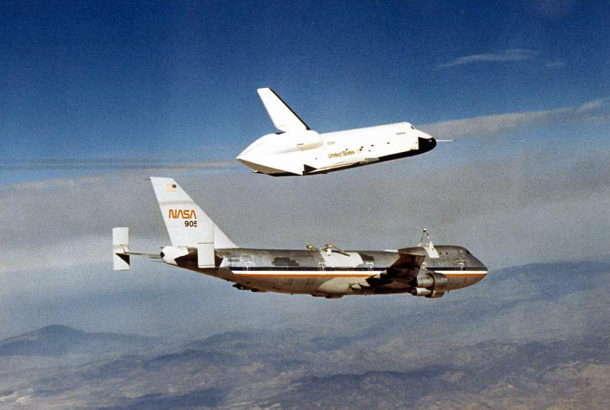
Forty-three years ago this month, the Space Shuttle Orbiter Enterprise successfully completed the first free flight of the Approach and Landing Tests (ALT) Program. NASA Astronauts Fred W. Haise, Jr. and Charles G. “Gordon” Fullerton were at the controls of the pathfinder orbiter vehicle (OV-101).
Developers of the Space Shuttle Orbiter faced the challenge of designing a vehicle capable of flight from 17,500 mph (Mach 28) at entry interface (400,000 ft) to 220 mph (Mach 0.3) at landing. Complicating this task was the fact that the Orbiter flew an unpowered, lifting entry that covered a distance of more than 4,400 nm. Once at the landing site, Shuttle pilots had a single opportunity to land the winged ship.
An Orbiter’s approach to the landing field is quite steep compared to that of a commercial airliner. Whereas the glide slope of the latter is around 2-3 degrees, the Orbiter’s flight path during approach is about 22 degrees below the horizon. Falling like a rock is an apt description of its flight state.
The Space Shuttle Approach and Landing Tests (ALT) involved a series of flight tests intended to verify the subsonic airworthiness and handling qualities of the Orbiter. Conducted at Edwards Air Force Base between February and October 1977, the ALT employed a modified Boeing 747 known as the Shuttle Carrier Aircraft (SCA). The Orbiter Enterprise was attached atop the SCA to hitch a ride to altitude.
The Shuttle ALT consisted of a total of thirteen (13) flight tests; five (5) Captive-Inactive (CI) tests, five (5) Captive-Active (CA) tests and three (3) Free Flight (FF) tests. CI testing was aimed at verifying the handling qualities of the SCA-Orbiter combination in flight. There was no crew was onboard the Orbiter for these tests. CA testing focused on preparing for the upcoming free flight series. A crew flew onboard the Orbiter which remained mated to the SCA.
The ALT Free Flights were where the rubber met the road so to speak. The Enterprise and her crew separated from the SCA at altitudes ranging from between 19,000 and 26,000 ft to test the Orbiter in free flight. Landings were made initially on Rogers Dry Lake (Runway 17) and ultimately on Edwards’ 15,000-ft concrete runway (Runway 22).
The Enterprise was flown in two (2) different configurations. The first involved the use of a tailcone fairing which streamlined the base region of the Orbiter. This increased the Orbiter’s lift-to-drag ratio which decreased the vehicle’s rate of descent. It also reduced the level of buffeting experienced by the SCA’s empennage while the Orbiter rode atop the carrier aircraft.
The second Enterprise configuration flown involved removal of the tailcone. This significantly reduced the Orbiter’s lift-to-drag ratio and correspondingly increased the rate of sink. Indeed, the Orbiter’s descent rate without the tailcone was roughly twice as high as that with the tailcone. Removal of the tailcone also markedly increased the buffet loads sustained by the SCA’s empennage.
ALT Free Flight No. 1 took place on Friday, 12 August 1977. With Fitzhugh L. Fulton, Jr. and Thomas C. McMurtry flying the SCA (N905NA), the Enterprise and her crew of Haise and Fullerton was carried to an altitude of 24,100 ft. At a speed of 310 mph in a slight dive, the big glider cleanly separated from the SCA. Just 321 seconds later, the Orbiter touched-down on Rogers Dry Lake at 213 mph.
ALT Free Flights No. 2-5 were successfully conducted over the next several months. Astronauts Joseph H. Engle and Richard H. Truly flew Enterprise on the second and fourth free flights while Haise and Fullerton manned the Orbiter’s cockpit on the third and fifth missions.
Enterprise flew without the tailcone during the last two ALT flights. As expected, the trip downstairs was rapid. Time of descent from 22,400 ft for Free Flight No. 4 was 154 seconds with a landing speed of 230 mph. Free Flight No. 5 took only 121 seconds to descend 19,000 ft and landed at 219 mph.
ALT Free Flight No. 5 was notable in that (1) the Enterprise made its first landing on concrete and (2) a Pilot-Induced Oscillation (PIO) occurred at initial touchdown. For a few tense moments Command Pilot Haise struggled to keep his skittish steed on the ground. Following several disturbing skips and bounces, the Enterprise finally settled down and rolled to a stop.
The Space Shuttle Approach and Landing Tests (ALT) were a necessary prelude to space for the Orbiter. Indeed, the ALT flights represent the first time that NASA’s new winged reentry vehicle took to the air. Having successfully demonstrated the ability to safely land an Orbiter, the next flight in the Space Shuttle Program would be STS-1 in April 1981. Interestingly, that 2-day mission would come to a successful conclusion when the Columbia landed on Rogers Dry Lake back at Edwards Air Force Base, California.

Sixty-one years ago to the day, Marine Lieutenant Colonel William Henry Rankin was forced to eject from his Vought F8U Crusader (SN 143696) when the aircraft’s turbojet engine seized at 47,000 feet. Unfortunately, Rankin’s post-bailout descent took him into a powerful thunderstorm that subjected the pilot to a cacophony of life-threatening horrors. Forty minutes after exiting his aircraft, Rankin landed in a forested area some 65 miles from his point of ejection.
Around 1700 hours EDT on Sunday, 26 July 1959, a two-ship formation of Marine F8U Crusaders departed South Weymouth Massachusetts bound for Beaufort, South Carolina. William Rankin, call sign TIGER ONE, was the formation commander with Marine Lieutenant Herbert Nolan, call sign TIGER TWO, flying wing. Since the 800 mile trip was considered routine and expected to take only 70 minutes, both airmen were dressed in only a light summer flying suit.
En-route to Beaufort, the Marine aviators encountered thunderstorm activity in the Norfolk, Virginia area. With thunderheads rising to around 44,000 feet, they ascended to 48,000 feet as a storm avoidance measure. Suddenly, Rankin heard an ominous thump and grinding noises coming from his engine. This was followed by another thump whereupon the red FIRE warning light began to glow. Rankin throttled back immediately. Perhaps he could save his engine and limp back home. Moments later that faint hope was dashed when engine power plummeted to zero. His engine had seized.
Working quickly, the aviator reached to deploy his Ram Air Turbine (RAT) in an attempt to maintain minimum levels of electrical and hydraulic power. Alarmingly, the RAT handle broke off in his hand! Quickly assessing his limited options, Rankin made the only choice that gave him a decent chance of survival; he ejected. Ejection occurred with his Crusader in a slight climb and a speed of several hundred miles per hours. The last altimeter reading Rankin saw before leaving the cockpit was 47,000 feet. The time of ejection was 1800 hours EDT.
Ejection from an aircraft is a physically brutal and dangerous event. It became even more so for Rankin as he instantly went from +75F in the cockpit to –70F outside air temperature. At 47,000 feet, the ambient static pressure is only 13% of the sea level value. Thus, the pilot simultaneously experienced rapid-onset frostbite and sudden decompression. The latter caused his abdomen to grotesquely swell several times its normal size and for blood to come out of his eyes, nose, ears, and mouth. The pain of atmospheric exposure was beyond excruciating.
As Rankin free-fell towards the dark storm clouds below, he tumbled, spun, and cart-wheeled wildly through the sky. The rotation-induced centrifugal force was so great that he was unable to move his limbs making him look much like a starfish. It suddenly occurred to Rankin that he needed to be breathing the oxygen in his bailout bottle to maintain consciousness and avoid possible brain damage. However, his oxygen mask was not in place and kept hitting him in the face as he spun. Entering the wispy white clouds at the top of the thunderhead, Rankin’s spin rate began to decrease to the point where he could now move his limbs. This allowed him to grab and hook-up his face mask whereupon wonderful life-giving oxygen began to flow into his lungs.
Rankin’s parachute was designed to open at 10,000 feet. After what seemed like an eternity of falling, his parachute deployed and blossomed as intended. Parachute deployment was quite violent and rattled Rankin’s battered body. He strained to see the canopy, but it was too dark to pick it out within the massive storm cell. Happily, Rankin could see and feel the taut risers which were connected to the canopy and he surmised that he indeed had a good chute. Things were starting to look up a bit for the battered Marine aviator.
What Rankin did not know at the time was that his parachute actually deployed at an altitude that was much higher than intended; somewhere between 15,000 and 20,000 feet. Not good. The resulting increased descent time would keep him in the storm longer. However, other than a little turbulence, the first minute or so on his chute did not portend what Rankin was about to experience.
With an alarming suddenness, Rankin was hit by a massive wall of turbulent air. It felt to him like he had hit a concrete wall. He went soaring up thousands of feet in a huge updraft. When the energy of the updraft finally dissipated, he started to descend again. Descent was worst than ascent. The pilot was buffeted and rattled violently in all directions. In Rankin’s words, he was “stretched, slammed, and pounded.” The rapid changes in g-force magnitude and direction caused him to vomit over and over. This terrible up-and-down process was repeated more times than Rankin could count. In all of this, the pilot was absolutely amazed and supremely grateful that his parachute held together.
Deep within the bowels of the violent storm, dark and roiling clouds seethed about Rankin and his vulnerable parachute. Just when it seemed that things couldn’t get any tougher, they did! The culprits were lightning, thunder, rain, and hail. The lightning and thunder encompassed him completely about. The former was like thick, intensely luminous sheets of blue. The latter was a horrific rolling explosion that Rankin intensely felt more than he heard. This meteorological one-two punch came every 30 to 60 seconds.
Rankin was exposed to torrential rains throughout his time in the storm cell. However, there were moments in which the rain was so intense that he gasped for air and thought he literally would drown in the sky. Then hail began to pound him. Rankin later said that it seemed like it was raining baseballs. Multitudinous hailstone impacts left a mass of welts that covered his entire body. Rankin said that he thanked his Maker that he was still wearing his helmet. Without it, he was certain that severe head injury would have resulted.
Eventually, the massive storm let go of William Rankin. He landed in a forest in North Carolina; 65 miles from the point of ejection. His watch told him that his battle with nature had lasted 40 minutes. His jet crashed 20 miles away and was vaporized on impact. (Happily, no one on the ground was hurt.) The story of his being rescued will not be told here. Suffice it to say that Rankin fully recovered and ultimately returned to flying as a Marine aviator. He lived 50 more years and passed from this mortal sphere in 2009 at the age of 89.
As a footnote, the reader is highly encouraged to read William Rankin’s “The Man Who Rode the Thunder” (Prentice-Hall, 1960). By doing so, one will come to more fully understand and appreciate just what Marine Lieutenant Colonel William H. Rankin experienced that eventful day in 1959.
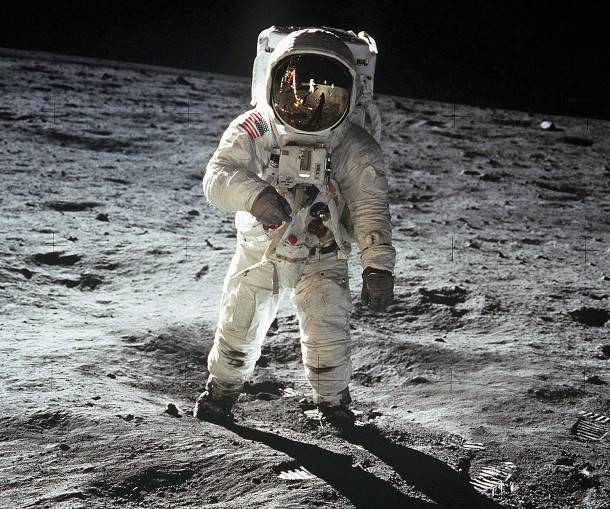
Fifty-one years ago today, the United States of America landed two men on the surface of the Moon. This feat marked the first time in history that men from the planet Earth set foot on another celestial body in the solar system.
The Apollo 11 Lunar Module Eagle landed in the Sea of Tranquility region of the Moon on Sunday, 20 July 1969 at 20:17:40 UTC. Less than seven hours later, Astronauts Neil A. Armstrong and Edwin E. Aldrin, Jr. became the first human beings to walk upon Earth’s closest neighbor. Fellow crew member Michael Collins orbited high overhead in the Command Module Columbia.
As Apollo 11 commander, Neil A. Armstrong was accorded the privilege of being the first man to step foot upon the Moon. As he did so, Armstrong spoke these words: “That’s one small step for Man; one giant leap for Mankind”. He had intended to say: “That’s one small step for ‘a’ man; one giant leap for Mankind”.
Armstrong and Aldrin explored their Sea of Tranquility landing site for about two and a half hours. Total lunar surface stay time was 22 hours and 37 minutes. The Apollo 11 crew left a plaque affixed to one of the legs of the Lunar Module’s descent stage which read: “Here Men From the Planet Earth First Set Foot Upon the Moon; July 1969, A.D. We Came in Peace for All Mankind”.
Following a successful lunar lift-off aboard the Eagle, Armstrong and Aldrin rejoined Collins in lunar orbit. Approximately seven hours later, the Apollo 11 crew rocketed out of lunar orbit to begin the quarter million mile journey back to Earth. Columbia splashed-down in the Pacific Ocean at 16:50:35 UTC on Thursday, 24 July 1969. Total mission time was 195 hours, 18 minutes, and 35 seconds.
With completion of the flight of Apollo 11, the United States of America fulfilled President John F. Kennedy’s 25 May 1961 call to land a man on the Moon and return him safely to the Earth before the decade of the 1960’s was out. It had taken 2,982 demanding days, a number of lives, and a great deal of national treasure to do so. “Mission Accomplished, Mr. President”.
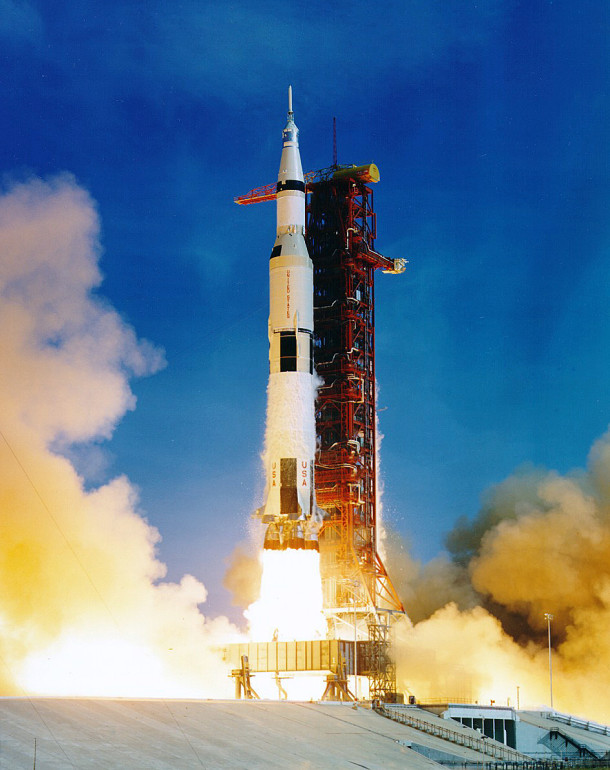
Fifty-one years ago today, the epic flight of Apollo 11, the first mission to land men on the Moon, began with launch from the Kennedy Space Center (KSC) at Merritt Island, Florida. Nearly 1-million people gathered around America’s famous space complex to witness the historic event. An estimated 1-billion viewers worldwide watched the proceedings on television.
The names of the Apollo 11 crew are now legend: Mission Commander Neil A. Armstrong, Lunar Module Pilot Edwin E. Aldrin, Jr., and Command Module Pilot Michael Collins. Each astronaut was making his second spaceflight.
The overall Apollo 11 spacecraft weighed over 100,000 pounds and consisted of 3 major components: Command Module, Service Module, and Lunar Excursion Module (LEM). Out of American history came the names used to distinguish two of these components from one another. The Command Module was named Columbia, the feminine personification of America, while the Lunar Excursion Module received the appellation Eagle in honor of America’s national bird.
The Apollo-Saturn V launch stack measured 363-feet in length, had a maximum diameter of 33-feet, and weighed 6.7-milllion pounds at ignition of its five F-1 engines. The vehicle rose from the Earth on 7.7-million pounds of lift-off thrust.
The acoustic energy produced by the Saturn’s first stage propulsion system was unlike anything in common experience. The sound produced was like intense, continuous thunder even miles away from the launch point. Ground and structure shook disturbingly and a person’s lungs vibrated within their chest cavity.
Lift-off of Apollo 11 (AS-506) from KSC’s LC-39A occurred at 13:32 UTC on Wednesday, 16 July 1969. The target for the day’s launch, the Moon, was 218,096 miles distant from Earth. It took 12 seconds just for the massive Apollo 11 launch vehicle to clear the launch tower. However, a scant 12 minutes later, the Apollo 11 spacecraft was safely in low earth orbit (LEO) traveling at 17,500 miles per hour.
Following checkout in earth orbit, trans-lunar injection, and earth-to-moon coast, Apollo 11 entered lunar orbit nearly 76 hours after lift-off. Now, the big question: Would they make it? Even Apollo 11’s Command Module Pilot, Michael Collins, estimated that the chance of a successful lunar landing on the first attempt was only 50/50. The answer would soon come. History’s first lunar landing attempt was now only 24 hours away.











